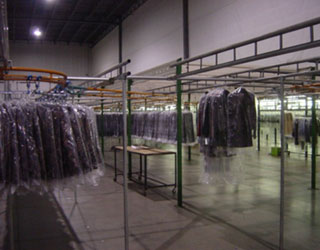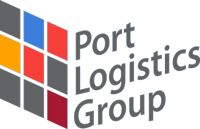DSI CUSTOMERS SAVE WITH VIRTUAL SUPPLY CHAIN SOLUTION
Distribution Solutions is now part of the Port Logistics Group and continues to use LANSA technology for its core warehouse management system and for web and AS2 communication with its customers.
Distribution Solutions Inc. (DSI), headquartered in Secaucus, New Jersey, USA, is a comprehensive logistics, distribution and transportation company. DSI’s services focus on critical supply chain initiatives, including postponement distribution, consolidation and deconsolidation, transloading, order replenishment and Internet order fulfillment. DSI’s two developers built all its IT systems with LANSA and manage all electronic data exchange with LANSA Integrator.
“The importance in our industry, of a flexible, easy to customize IT system is well illustrated by the fact that either our CIO or myself usually come along on sales calls,” explains David Meenen, IT manager at DSI. “To get new customers on board it is crucial that we can meet their requirements and integrate with their IT systems.”
It is crucial that we can meet customer requirements and integrate with their IT systems.
- One-stop Shop Distribution
- An Integrated WMS is the Core
- Seamless Information Flow
- Outsourcing the Supply Chain
- Company and System Information
One-stop Shop Distribution
Founded in 1989 by its current CEO Jeffrey M. Wolpov, DSI is a continuation of a family business that dates back to 1969. With deep roots in the garment industry, DSI has developed into a comprehensive service provider handling general merchandise, hard and soft lines, consumer goods and apparel.
Today, the company operates from three primary warehouse facilities with over 1.2 million square feet of warehouse space, manages a fleet of 100 trucks and employs 500 staff.
DSI’s Garment On Hanger (GOH) facilities include miles of storage rack capacity and specialized pressing, refurbishing, quality control and ticketing services.
“We aim to be the one-stop shop distribution solution provider for our customers,” says Wolpov. “Distribution is much more than loading and unloading from an airplane to a truck. It is about managing every aspect of the supply chain. It is about having the right product, at the right spot and at the right time. It is about speed to market. Key in this business is a seamless flow of information.”
During the nineties, DSI purchased and developed systems to support its logistics business, but they lacked the flexibility to support diverse customer requirements. At that time, DSI did not have a Warehouse Management System (WMS) and was investigating tools to develop one.
“We needed a flexible and productive development environment that would give us easy customization and total control,” says Chuck Feldman, CIO at DSI. “I already had experienced the benefits of developing in a 4GL and felt it was not a good plan to continue with a 3GL like RPG.”
“Our first introduction to LANSA was a packaged accounting solution. LANSA’s practical approach to software development fits our pragmatic business culture, so in 2000 we chose LANSA as our development platform to develop our WMS from scratch.”
DSI has since used LANSA to provide web access for customers and for handling AS2 (EDI over the Internet), EDI, FTP and email transactions with customers.
Distribution is about managing every aspect of the supply chain. Key in this business is a seamless flow of information.
An Integrated WMS is the Core
“A typical implementation starts with a customer sending us their item master data,” explains Julie Lai, senior developer at DSI. “We retrieve that data through LANSA Integrator AS2 services. The item master data is then massaged into our WMS file structure with codes to recognize the customer’s specific business rules. Once the master files for a customer have been set up, we are ready to move goods for them.”
Shipment requests are also processed via LANSA AS2 services. DSI, via its Jefco trucking division, provides airport and pier pickup and handles customs procedures for its customers. DSI’s truck drivers carry handheld devices to receive their pick-up orders and provide up-to-the-minute status updates to DSI’s system. DSI’s link with the Automated Manifest System notifies DSI and its customers within 10 minutes of U.S. Customs releasing goods.
All three of DSI’s warehousing facilities are wireless and when containers are delivered for transloading, warehouse staff use wireless guns to scan pallets and GOH as they are placed in a location – instantly updating the inventory which DSI’s customers can view in real time over the web.
“Pick tickets mostly arrive through AS2, but may also be entered on our web site or sent by fax. Over 85 percent of our orders arrive electronically and are processed directly without any human intervention into our WMS,” explains Meenen.
“Our key area of expertise is just-in-time store replenishment, responding super fast to shipment requests from our customers. While we use our own Jefco truck fleet for picking up containers from airports and ports, most of the delivery to the retail store outlets is via United Parcel Services (UPS), FedEx or a carrier that the customer nominates.”
For each shipment a bar-coded pick list is printed. Warehouse staff scan the barcode, read the location and take goods to a packing station. Order information is pulled from the System i and a UCC-128 label with delivery details is printed. A Bill of Lading is created and carrier tracking codes associated with the pick order, inventory is updated, an email is sent to the customer, an advanced shipping notice is sent to the party who will receive the goods and the pick order is closed.
“The nucleus is our WMS,” summarizes Lai. “It is 80 percent LANSA RDML code, 15 percent CL code and 5 percent RPG.”
“The middle core consists of special implementations, the code that enables customer specific rules and processes. The outer layer takes care of the communication with the outside world, including the import and export of data and AS2 and EDI transactions via LANSA Integrator services. Customers can view all information using our website or via Mocha 5250 terminal emulation.”
Over 85 percent of our orders arrive electronically and are processed without any human intervention.
Seamless Information Flow

“Each new customer is effectively a new implementation,” says Feldman. “Using LANSA, we have delivered a flexible WMS solution that can meet the needs of each customer implementation.”
“We work closely with our customers,” adds Meenen. “We help them with their file layout and go through different designs and ways to exchange information. Some of our customers use XML or EDI, but others simply email us their orders as spreadsheet attachments or use FTP. With LANSA we can setup automated workflow procedures for all our customers.”
“We went from a system that was predominantly manual to a solution where over 85 percent of data exchange with customers is electronic. We can now upload a few hundred orders in a couple of minutes, where before orders had to be keyed in by customer service, which took several hours.”
“Exchanging information electronically has cut costs for our customers as well. It has also improved accuracy and taken hours from our order fulfillment procedures.”
“Web tracking and automated data exchange has helped to establish a seamless flow of information between our customers and us. If the information is always available, accurate, up-to-date and integrated with a company’s in-house systems, it doesn’t matter whether an internal or external party provides the information. It becomes irrelevant.”
“LANSA’s 4GL makes life a lot easier. You don’t have to worry about sub-files or any other low-level coding. LANSA takes care of all that and lets us concentrate on the business issue at hand. In addition, the repository of fields, files and components provides consistency across our applications.”
“LANSA provides a very productive development environment. With a small development team of two and with the help of the LANSA toolset, we have delivered systems that let our customers run their logistics in a very efficient way.”
“The reliability of our IT environment, both LANSA and the System i, are crucial to us. We run a minimum of two shifts per day in our warehouse, with three shifts during the busy season. We cannot afford any down time. It is even hard to find a few hours in the weekend to upgrade software,” says Meenen.
With a small development team of two and the help of the LANSA toolset, we have delivered systems that let our customers run their logistics in a very efficient way.
Outsourcing the Supply Chain
“We can help our customers manage all their back office distribution services,” says Wolpov. “We can work with their broker, collect their freight, store their goods, participate in their quality control, replenish their stores, drop ship to their customers, do their data entry and generate their picking lists and invoices.”
“Outsourcing warehousing and distribution requires a seamless flow of information. Our WMS and front-end office systems enable the required flexibility in the ever-changing retail business environment. Technology drives our operations. We do this through our in-house technology team and are dedicated to providing a system that can meet the changing needs of today’s business world.”
“We want to be a partner in distribution, allowing our customers to focus on their core competency and help them grow the business. We want to help our customers do their supply chain at a variable cost. Managing the supply chain is for many companies the last opportunity to take margin under control,” concludes Wolpov.
Our systems enable the required flexibility in the ever-changing retail business environment.
Company and System Information

- Distribution Solutions is now part of the Port Logistics Group and continues to use LANSA technology for its core warehouse management system and for web and AS2 communication with its customers.
- DSI provides nationwide distribution and warehousing services that focus on retail consumer goods. DSI’s warehousing facilities are US customs bonded and cater for both flat pack cartons as well as Garment On Hanger (GOH) services. DSI’s GOH facilities include miles of GOH storage rack capacity and specialized pressing, refurbishing, quality control and ticketing services. DS has over 1 million square feet warehouse space, employs 500 staff and operates a fleet of over 100 trucks. For more information visit www.portlogisticsgroup.com/
- DSI has a single IBM System i 520 and mirrors to a second 515, using iTERA HA.
- DSI uses Trusted Link EDI translation software from Inovis, as well as LANSA EDI Direct.
- DSI’s IT team consists of two developers (one part time), the IT manager and one network support person.

